hist78
Well-known member
Merry Christmas to everyone!
I did a study on recent CPU sales on Amazon in the US, Germany, and Japan. In the US, all of the top 10 best sellers are from AMD, and 15 out of the top 20 are from AMD, with only 5 from Intel. AMD also performed very well in the Amazon Germany and Amazon Japan marketplaces. This is a significant difference in sales performance between AMD and Intel.

The following is Amazon's explanation of how they rank the 'Best Sellers".
"Amazon calculates Best Sellers Ranks using sales volume data. Both recent sales and all-time sales factor into a BSR, though recent sales count more than older sales."
"BSRs aren’t influenced by page views or customer reviews. A sales rank doesn’t necessarily indicate product quality or tell you what customers think about a product.
A product can have more than one BSR number if it falls under multiple categories, and the BSR can be different for each. For example, a stainless-steel tumbler might rank #1 in the Tumblers & Water Glasses subcategory and rank #2 in the Kitchen & Dining category.
Rankings can also vary depending on the Amazon store. For example, an item ranked #1 in the US might rank #23 in the Amazon UK or Japan stores."
Best Sellers Ranks: https://sell.amazon.com/blog/amazon-best-sellers-rank#:~:text=The Amazon Best Sellers Rank (BSR) is a metric that,page views or customer reviews.
I did a study on recent CPU sales on Amazon in the US, Germany, and Japan. In the US, all of the top 10 best sellers are from AMD, and 15 out of the top 20 are from AMD, with only 5 from Intel. AMD also performed very well in the Amazon Germany and Amazon Japan marketplaces. This is a significant difference in sales performance between AMD and Intel.
The following is Amazon's explanation of how they rank the 'Best Sellers".
"Amazon calculates Best Sellers Ranks using sales volume data. Both recent sales and all-time sales factor into a BSR, though recent sales count more than older sales."
"BSRs aren’t influenced by page views or customer reviews. A sales rank doesn’t necessarily indicate product quality or tell you what customers think about a product.
A product can have more than one BSR number if it falls under multiple categories, and the BSR can be different for each. For example, a stainless-steel tumbler might rank #1 in the Tumblers & Water Glasses subcategory and rank #2 in the Kitchen & Dining category.
Rankings can also vary depending on the Amazon store. For example, an item ranked #1 in the US might rank #23 in the Amazon UK or Japan stores."
Best Sellers Ranks: https://sell.amazon.com/blog/amazon-best-sellers-rank#:~:text=The Amazon Best Sellers Rank (BSR) is a metric that,page views or customer reviews.
Last edited:


